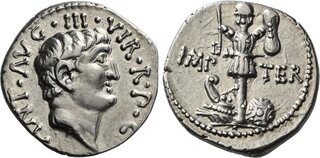| Numismatica Ars Classica > Auction 143 | Auction date: 7 May 2024 |
| Lot number: 434 Price realized: This lot is for sale in an upcoming auction - Bid on this lot  | Show similar lots on CoinArchives Find similar lots in upcoming auctions on |
| Lot description: The Dioscuri Collection. The Roman Republic. Marcus Antonius. Denarius, mint moving with M. Antonius 37, AR 19 mm, 4.01 g ANT·AVGV (partially ligate)·III·VIR·R·P·C Head of M. Antonius r. Rev. IMP – TER Trophy with curved sword attached to r. arm and figure-of-eight shield attached to l.; at its base, prow and round shield. Babelon Antonia 78. C 18. Sydenham 1204. Sear Imperators 272. RBW 1824. Crawford 536/3 note. Very rare. Struck on a very large flan and with a light iridescent tone. Good extremely fine Ex Roma Numismatics sale XIII, 2017, 659. After the assassination of Julius Caesar on the Ides of March 44 BC, his former lieutenant, Mark Antony, became the de facto leader of the Caesarean faction in Rome. Unfortunately, Caesar's will named his adoptive great-nephew Octavian as his heir, forcing Antony to fight against him for much of the remainder of 44 and 43 BC. However, in May 43 BC, Octavian began to negotiate an end to the conflict in order to join forces against the threat posted to both of them by the formation of large armies under the command of the Liberatores in the East. Despite their deep differences, in November, Antony, Octavian, and Marcus Lepidus met to form the Second Triumvirate and raise the armies that defeated the Liberators at the Battle of Philippi (3 and 23 October 42 BC). In the aftermath of this great victory, in order to keep peace, the empire was divided, with Octavian taking Italy and the West, Lepidus North Africa, and Antony the East. In 37 BC, the division of the empire and the Triumvirate was renewed among the three mend for another five years, but by this time the old animosity between Antony and Octavian was returning and it would not be long before it would break out into an epoch-ending war in 32-31 BC. This denarius was struck in the year of the renewed Triumvirate, probably in the context of Antony's work to restore order in Syria and the eastern provinces following a Parthian invasion in 40 BC. This was followed up by a somewhat ineffective campaign against the Parthians in 36. The precise occasion for this issue appears to have been the repression of Antiochus I of Commagene, who previously rebelled against Roman authority during the Parthian invasion. The reverse type depicting a trophy and advertising Antony's third acclamation as imperator is thought to refer to his taking personal command of the siege of Samosata, which the general P. Ventidius was already successfully prosecuting against Antiochus I. Although the king offered to surrender, Antony would not provide him with terms until he could arrive and take over the siege himself, thereby allowing him to claim the glory. Antony reportedly gave peace terms to Antiochos I that included an indemnity of 300 talents of silver, although when facing Ventidius he had offered to pay 1,000 to have the siege lifted. Antony then returned Ventidius to Rome, where he celebrated the first ever Roman triumph over the Parthians. Antony's claim of a third imperatorial acclamation on this coin is believed to derive from Ventidius' triumph and does not truly reflect an acclamation properly earned by the triumvir. It has been noted that the trophy reverse type seems to echo the types used on the Asian coinage of Brutus issued four years earlier, but it seems a little out of place for Antony's Parthian war context. The arms displayed are not particularly Parthian and the figure-eight shield is decidedly archaic in flavour. Likewise, the prow at the foot of the trophy is rather unexpected since sea power had virtually no involvement in the Parthian campaign. It has been suggested that the prow, which sometimes appears as part of Brutus' trophy type, might have been added to generally emphasise the superiority of Antony's naval strength at a time when his rival, Octavian, was weak at sea. Likewise, the possibility has been raised that the general similarity to Brutus' trophy might reflect regret on the part of Antony as he drifted ever closer to the final conflict with Octavian Estimate: 4000 CHF |  |



